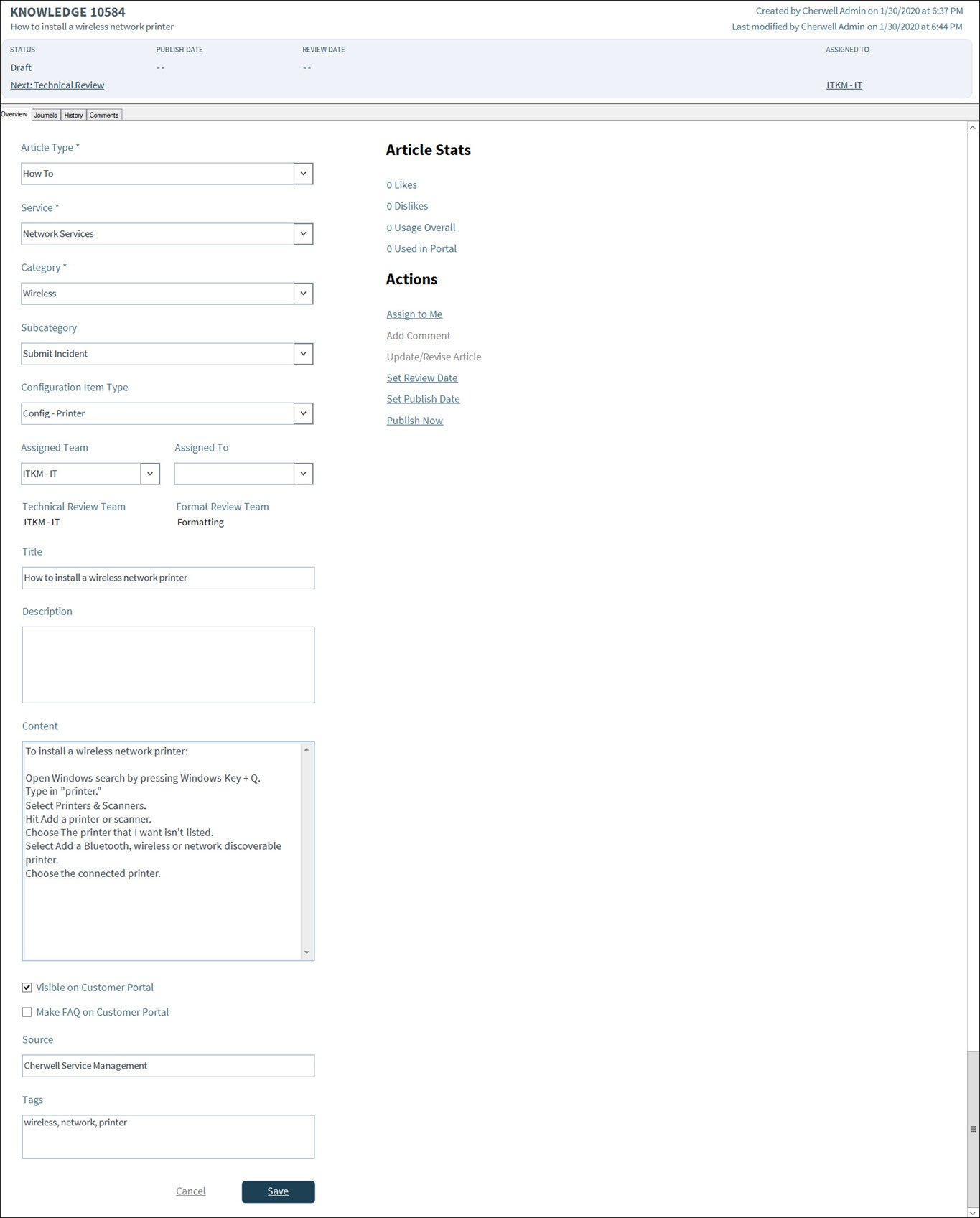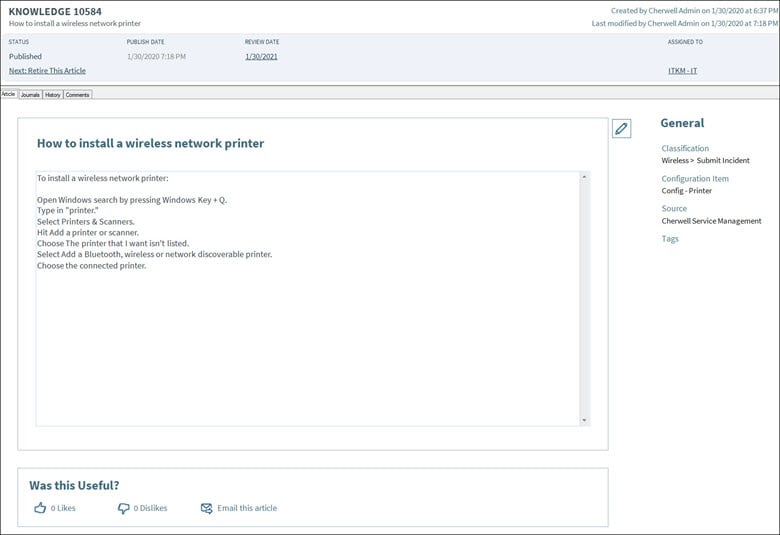Knowledge-IT Forms
All of the following are Knowledge-IT forms: Knowledge Article, Knowledge Article Overview, Knowledge Article Read Only View, and Knowledge Article Summary.
Overview
In the CSM Desktop Client and CSM Browser Client, the Knowledge Article and Knowledge Article Overview forms display in the Overview tab when creating a new KA. There are five main sections displayed:
- Knowledge Article Form: Displays important at-a-glance information at the top of the window, including Knowledge ID, status, next step in the Knowledge Article Workflow, publish date, review date, and assigned to owner and/or Knowledge team.
- Form Arrangement Tabs: Dynamically displays a tabbed collection of child forms and records that are in a relationship with the parent form.
- Form Fields: This section of the window displays the form fields for the selected tab. The Overview tab contains the Knowledge Article Overview form for creating a new Knowledge Article. Once the form is in Published status, the Overview tab disappears and the Knowledge Article Read-Only View form displays in the Article tab.
- Article Stats (part of Knowledge Article Overview form): Displays statistics for the current KA.
- Actions List (part of Knowledge Article Overview form):
Dynamically displays a list of actions that are available for the current KA.
Note: For more information, see Knowledge Article Workflow One-Step Actions.

Knowledge Article Form
The Knowledge Article form displays important at-a-glance information at the top of the window, including Knowledge ID, status, next step in the KA workflow, publish date, review date, and who it is assigned to.
The following table describes the fields on the Knowledge Article form.
* Required field
| Field | Description | Comments |
|---|---|---|
| Knowledge [ID] | Unique record identifier (example: 10380) for the KA. | CSM automatically assigns the ID when the KA is created. |
| Status: Draft | Creator logs a new KA or modifies an existing one, adding as much information as possible to the form. When the article is ready for review, the creator selects Next: Technical Review. One-Step Action changes status to Technical Review. Email is sent to ITKM Technical Review Team. KA appears on Knowledge Management dashboard. KA becomes read-only and is editable only by the ITKM Technical Review team. | |
| Status: Technical Review | ITKM Technical Review Team member reviews
the KA for technical accuracy and approves the KA by selecting
Next: Technical Review Complete.
If Visible on Customer Portal is NOT selected on the form, One-Step Action changes status to Published. If Visible on Customer Portal is selected on the form, One-Step Action changes status to Formatting Review. An email is sent to Format Review team. KA becomes read-only and is editable only by the Format Review team. |
|
| Status: Formatting Review | If Visible on Customer Portal is selected on the form, a member of the Format Review team reviews KA and approves it by selecting Next: Formatting Review Complete. A One-Step Action changes status to Published. | |
| Status: Published | If the Technical Review team (and Formatting Review team if visible on CSM Portall) have completed review, One-Step Action changes status to Published. The KA is published to the Knowledge Base (using the Business Process engine) in read-only view. Consumer accesses KA (user in CSM and customer in CSM Portal). To simplify the form for reading, the Overview form is hidden from view. One-Step Action schedules a review date in one year. This date can also be manually set on the form. | |
| Publish Date | The date the KA was last published. | CSM automatically fills in the date the KA was last published. |
| Review Date | The next scheduled review date. This autofills with the date one year from the publish date. This field can be modified. | CSM automatically fills in one year from the publish date. |
| Assigned To | Name of the individual user and team currently working on the KA. | CSM automatically fills in the user and team names. |
Knowledge Article Overview Form
In the CSM Desktop Client and CSM Browser Client, the Knowledge Article Overview form displays in the Overview tab when creating a new KA.
The following table describes the fields on the Knowledge Article Overview form.
| Field | Description | Comments |
|---|---|---|
| *Article Type |
Type of KA:
|
*Required. |
| *Service |
Service that the KA relates to:
|
*Required. Autofills when created from an Incident or Problem. See the table in Knowledge Management Teams for a list of teams and how they autofill according to the selected Category. |
| Category | Service Category that the KA
relates to:
|
Autofills when created from an
Incident or Problem.
The Category selected in this field determines which teams will autofill the Assigned Team, Technical Review Team, and Format Review Team fields. See the table in Knowledge Management Teams for a list of teams and how they autofill according to the selected Category. |
| Subcategory | Service Subcategory that the KA relates to (example: Submit Incident). | Not always applicable. Autofills when created from an Incident or Problem. |
| Configuration Item Type | The type of Configuration Item that the KA relates to. | |
| Assigned Team | Autofills based on the
selected Category. Matches the
Technical Review Team.
Note: You can manually change the
Assigned Team after selecting the
Category. For example, you may want to
assign the KA to yourself when it is in Draft form. However, once you submit
the KA for Technical Review, the
Assigned Team will automatically
change to match the
Technical Review Team.
|
See the table in Knowledge Management Teams for a list of teams and how they autofill according to the selected Category. |
| Assigned To | Select a specific user or allow the individuals within the assigned team(s) to assign to themselves. | The options in this field are limited to the individual users in the current team (based on Status). |
| Technical Review Team | Autofills based on the selected Category. | See the table in Knowledge Management Teams for a list of teams and how they autofill according to the selected Category. |
| Format Review Team | Autofills based on the selected Category. | See the table in Knowledge Management Teams for a list of teams and how they autofill according to the selected Category. |
| Title |
Title of KA. |
Try to match what people will be searching/browsing for.
Tip: Include feature name and recognizable words,
such as "How To Reset a Password".
|
| Description | Description of the article. | |
| Content | Details of the article, such as step-by-step instructions. | |
| Source | Source of KA. | This field reflects the Business Object the article originated from (example: Incident or Problem) when Submit to Knowledge Base is used from the Business Object. |
| Tags | List of keywords, separated by commas and a space, related to the KA that can help with categorization and searching. Select synonyms, related terms, regional versions, usual typos, etc. | |
| Article Stats |
Current statistics, which include:
|
Usage is tracked using the
KnowledgeArticle.KnowledgeUsageCount
expression.
|
| Actions List | Dynamic display of the Actions available for the current KA. | |
| Assign to Me | Makes the current user the owner of the KA. The current user's name appears in the Assigned to field. | |
| Add Comment | Opens a window to add a comment for the Knowledge team to review. The comment appears as a Journal-Note entry in the Journals tab and Comments tab of the form arrangement. | |
| Update/Revise Article | Opens a window to select a Knowledge team member from a drop-down list. You can also select the Ellipsis (...) button. | |
| Set Review Date | Allows members of the Knowledge Management teams to set the Review Date to something other than the default value, which is one year from Publish Date. | |
| Set Publish Date | Allows members of the Knowledge Management teams to set a future Publish Date. | |
| Publish Now | Allows a Knowledge Manager or a Cherwell admin to skip the Technical Review and Formatting Review and go directly to Publish. If Visible on Customer Portal is selected, a prompt displays confirming that you want to publish this KA to the CSM Portal. Select True or False, then select OK. | |
| Reject This Article | Rejects the KA. | |
| Retire This Article | Retires the KA. |
Knowledge Article Read-Only View Form
The Knowledge Article Read-Only View form displays in the Article tab once the KA is published. To simplify the reading experience of the published KA, the Overview tab no longer displays.

The following table describes the fields on the Knowledge Article Read-Only View form.
| Field | Description | Comments |
|---|---|---|
| Article Content | Displays the title and content of the article. | |
| Pencil icon | Members of the Knowledge Management teams can select this to modify the KA. | |
| Was this useful? | This form section allows user to provide feedback on the KA and email to others. | |
| Likes | Allows user to like the KA. | Like Count Value displayed. |
| Dislikes | Allows user to dislike the KA. | Dislike Count Value displayed. |
| Email this article | Technicians can select to email KA to someone. | |
| Classification | The Classification Value of the KA is determined by the Service, Category, and Subcategory. | Uses an expression:
KnowledgeArticle.Category Custom expression [If
KnowledgeArticle.SubCategory is not empty then > Default: empty]
KnowledgeArticle.SubCategory |
| Configuration Item Type | The type of Configuration Item that the KA relates to. | |
| Source | Source of KA. | |
| Tags | List of keywords related to the KA that can help with categorization and searching. |
Knowledge Article Summary Form
The following table describes the fields on the Knowledge Article Summary form.
| Field | Description | Comments |
|---|---|---|
| Title | Title of KA. | |
| Assigned To | Name of the individual user and team currently working on the KA. | CSM automatically fills in the user and team names. |
| Article Type | Type of KA:
|
|
| Status | The current status of the KA within the Knowledge Article Workflow. See the Knowledge Article form fields for a specific list of status options. | CSM automatically fills in the status. |
| Usage Count | Number of times the KA has been used. | Usage is tracked using the KnowledgeArticle.KnowledgeUsageCount expression. |